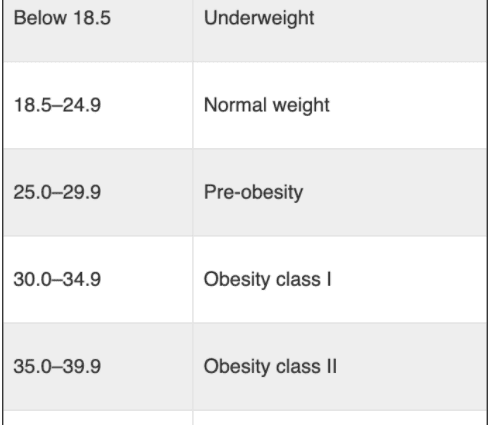Contents
The Body Mass Index (BMI) is a quick and easy way to correlate your weight with your height. Adolphe Quetelet came up with this formula in 1830-1850.
BMI can be used to determine the level of obesity of a person. BMI measures the relationship between height and weight, but does not distinguish between fat (which weighs little) and muscle (which weighs a lot), and does not represent actual health status. A thin, sedentary person may have a healthy BMI, but feel unwell and lethargic, for example. And finally, BMI is not calculated correctly for everyone (calorifier). For children under 14, pregnant women and bodybuilders, for example, BMI will not be correct. For the average moderately active adult, the BMI will help determine how close or far off your weight is.
Calculation and interpretation of BMI
You can calculate your BMI in the following way:
IMT = the weight divide by growth in meters squared.
Example:
82 kilograms / (1,7 meters x 1,7 meters) = 28,4.
According to current WHO standards:
- Less than 16 – weight deficit (pronounced);
- 16-18,5 – underweight (underweight);
- 18,5-25 – healthy weight (normal);
- 25-30 – overweight;
- 30-35 – degree I obesity;
- 35-40 – grade II obesity;
- Above 40 – obesity III degree.
You can calculate your BMI using our Body Parameters Analyzer.
Recommendations according to BMI
Being underweight can be critical, especially if it has been caused by illness or eating disorders. It is necessary to adjust the diet and consult a specialist – a therapist, nutritionist or psychotherapist, depending on the situation.
People with a normal BMI are advised to aim for the mid-range if they want to improve their figure. Here you should pay more attention to the rules for burning fat and the composition of the BJU of your diet.
Overweight people should strive for a norm – reduce calories and change their diet so that it is dominated by whole foods that have undergone minimal processing – meat, poultry and fish instead of sausages and convenience foods, cereals instead of white bread and pasta, fresh vegetables and fruits instead of juices and sweets. Particular attention should be paid to strength and cardio training.
Obesity increases the risk of developing a number of diseases, so it is necessary to take measures now – to remove simple carbohydrates and foods containing trans fats from the diet, gradually move on to proper nutrition and introduce feasible physical activity. Obesity treatment of II and III degrees should be carried out under the supervision of a physician.
BMI and body fat percentage
Many people confuse BMI and body fat percentage, but these are completely different concepts. As mentioned above, BMI does not take into account body composition, so it is advisable to measure the percentage of fat and muscle on special equipment (calorizator). However, world renowned nutritionist Lyle MacDonald offers a way to roughly estimate body fat percentage based on body mass index. In his book, he proposed the table you see below.
The result can be interpreted as follows:
So, knowing your BMI allows you to understand how your weight is close or far from the norm of the World Health Organization. This indicator does not indicate the actual body fat content, and trained people with large muscle mass can be confusing at all. The table suggested by Lyle MacDonald is also designed for the average person. If it is important for you to know your exact percentage of fat, then you need to undergo a body composition analysis using special equipment.










